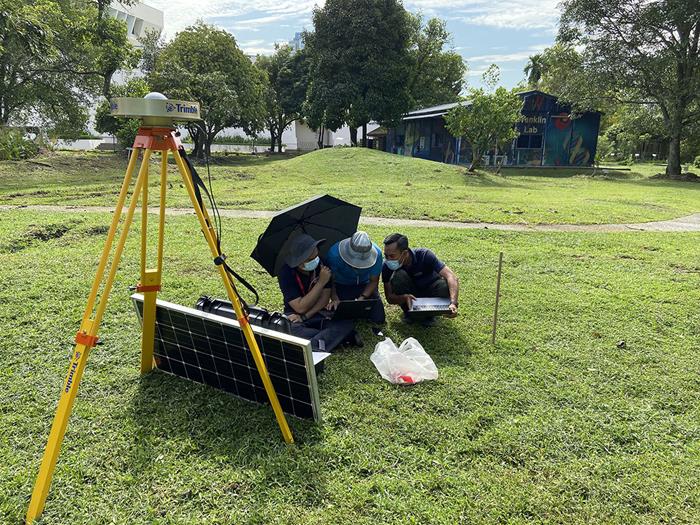Do you know what the most abundant greenhouse gas in our atmosphere is? Hint: it’s not carbon dioxide.
If you guessed water vapour, you are right! Water vapour plays a large role in the Earth’s climate and weather. The amount of water vapour in the atmosphere increases with temperature, reinforcing climate change. At a local scale, it also affects the occurrence and intensity of rainfalls and droughts.
Scientists from the Earth Observatory of Singapore (EOS) are tapping into Global Positioning Systems (GPS) to collect water vapour data more widely across Singapore, to help understand changes in the atmosphere at different timescales.
In their search for new GPS sites, the Science Centre Singapore (SCS) came to mind almost immediately. Located in the west, SCS is almost equidistant from three surrounding stations, making it an ideal spot for increasing the network’s density.
The new GPS station would also complement Earth Alive, a permanent exhibition EOS and SCS created to encourage the discovery of our Earth's systems. The EOS team was excited to harness the Science Centre’s position as a hub for fostering public interest in science.
SCS was very supportive of this new development, and on 25 July 2022, a GPS station was born at the Science Centre Singapore.

Map depicting the GPS Stations in Singapore that EOS scientists retrieve data from. Aside from the EOS stations, EOS also draws on a partnership with the Singapore Land Authority to access data from the Satellite Positioning Reference Network (SiReNT), which has GPS stations across Singapore. (Source: Jay Wong/Earth Observatory of Singapore)
Installing the station
The main requirement for a GPS site is open space because an uninterrupted path from the satellite to the GPS antenna is needed for signals to be transmitted. With that in mind, collaborators from SCS suggested two potential spots: the Observatory, an area built for stargazing, and the Ecogarden, a beautiful green space that is open to visitors.
To test the two candidate locations, a team from the EOS Centre for Geohazard Observations (CGO) set up temporary stations in a campaign survey that recorded data for a week. The data showed similar results across both locations and proved both sites to be viable options.
 CGO members setting up the instrument box of the temporary station, along with a solar panel structure and a GPS antenna on a portable tripod. (Source: Lujia Feng/Earth Observatory of Singapore)
CGO members setting up the instrument box of the temporary station, along with a solar panel structure and a GPS antenna on a portable tripod. (Source: Lujia Feng/Earth Observatory of Singapore)
Ultimately, the Ecogarden was chosen because it receives more visitors and would provide more learning opportunities. It took a stroke of luck too. The site at the Ecogarden opened because a tree had recently fallen over, clearing up tree cover for a clear satellite view.
The team then promptly embarked on the installation of the permanent station. From drilling deep into the ground to set up the tripod, to mounting a solar panel and putting the parts of the GPS antenna together, the team completed the installation in three days. On one of the days, they even had the company of groups of children on a mission to pick up litter from the Ecogarden pond, demonstrating the high amount of activity there.
 The completed GPS station at the Ecogarden and its component parts. (Source: Lujia Feng and Jay Wong/Earth Observatory of Singapore)
Part of a larger network
The completed GPS station at the Ecogarden and its component parts. (Source: Lujia Feng and Jay Wong/Earth Observatory of Singapore)
Part of a larger network
EOS continues to plan for more stations to fill the gaps between existing sites, which will improve the understanding of atmospheric processes at local scale. For example, CGO is exploring the installation of two new stations in Kranji and Braddell.
While physical work under poor weather conditions may sometimes be challenging, it is all part of the journey to learn more about the most abundant greenhouse gas in our atmosphere.